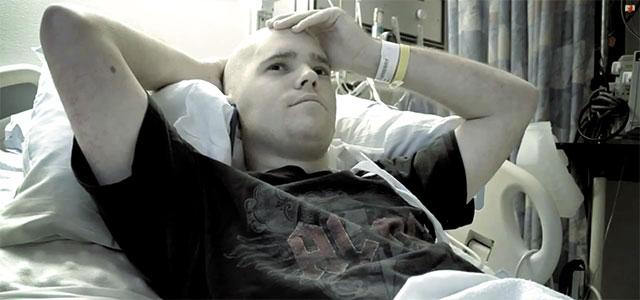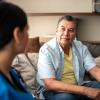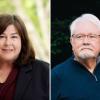
Steven Rodriguez at UCSF Benioff Children’s Hospital San Francisco
A Nursing Story
When the headaches began early in 2013, Steven Rodriguez was a 19-year-old college student living in Southern California. Several doctors treated him unsuccessfully for the suspected causes: wisdom teeth (four were extracted), stress, poor diet. Yet despite pain medication, the headaches worsened, and on May 13, Steven wound up in the emergency room only to be sent back to his apartment. When he got there, he threw up and fainted at the foot of his stairs.
After repeated calls to his Southern California physicians, Steven’s mother, Alex, decided her only course of action was to bring him home to Marin County’s Tamalpais Valley. She flew down and back on May 14, bringing Steven home with her.
The journey was a physical and emotional struggle, as the normally vital 19-year-old could not walk due to his pain medication; Alex had to wheel him through the airport. Upon landing, she received a message from one Southern California physician, suggesting that given his symptoms, Steven should go to the emergency room right away. But Steven insisted he was too tired and only wanted to go to bed. Eventually, after much debate, Alex says, she yielded to her son.
He woke screaming at 4 a.m. the next morning, and Alex rushed him to the local emergency room. Physicians there were set to send Steven home again – he was determined to be brave and undersell his pain – but his mother insisted on a CT scan. A heated discussion ensued – because he was no longer a minor, Steven was the ultimate decisionmaker – and the nurses eventually removed Alex from the room.
Hours later, she was still sitting in the waiting room, feeling dismissed and expecting that Steven would be discharged, when her husband, Rafael, arrived. The hospital had called him, at Steven’s insistence, so Alex wouldn’t be alone to hear the news: The doctor had finally agreed to the CT scan, which revealed a 7-centimeter tumor in Steven’s brain.
On May 15, 2013, Steven underwent a seven-hour surgery to remove the tumor. When the histology report came back nine days later, it identified the tumor as an AT/RT (atypical teratoid/rhabdoid tumor), a very aggressive cancer that typically appears in younger children but is extremely rare in adults.
“I couldn’t comprehend what we were told,” says Alex. “We struggled for a while, but the community we live in is very loving. We sent out an angel alert, and people came rushing and told us UCSF is the place to go, because they’re doing the clinical trials and have the experience. [At UCSF they told us] either do the treatment or die.… Steven just sat there dazed.”
When he entered UCSF Benioff Children’s Hospital San Francisco on June 17, neither he nor his family knew he would spend most of the rest of his life there. Surrounded by the love and strength of his family and friends, Steven – who was a dedicated vlogger – documented that time in a series of heart-wrenching videos. He died on October 17, 2013.
Among the friends Steven and his family cherished during his stay were the nurses on the 7th floor. Balancing clinical care, communication and emotional support for patients and families is the job description for most nurses, but the painful journey of the Rodriguez family heightened the challenge for the nurses on what was known as “7 Long.”
UCSF: Day One
Alex Rodriguez: Steven’s protocol was set for chemo with radiation; it was very aggressive treatment, and he was so tired. Our very first encounter with a nurse was with Francis, who snuck into the room with a little flashlight, and you would not even have realized he was there. He checked vitals, checked the tray, adjusted a few things and snuck out. Not once did he wake up Steven or make a noise. His first and only thought was that Steven needed to rest. My experience in a hospital had been giving birth, and you don’t get any rest; they wake you up, turn on lights. Francis was angel-toed. I saw him the next day and said, “Thank you for not waking him up.”
Connecting with Steven
Kenny Truong, bedside nurse: It was right at the beginning.… I remember at handoff, changing shifts, someone telling me, “You’ll like this one – he’s a really nice kid.” He was a theater major in SoCal, and I had wanted to do theater for college originally. So I wanted to see who this person was, someone bold enough to pursue that career. Each patient you meet and bond over something; for him and me, it was acting. We loved acting. I remember talking to him about that so much. When you share similar interests, you can open up more. And in the acting world, you learn to let your guard down because you have to. No being macho. I got to know him in that way.
AR: Kenny was very kind and compassionate.… He was on nights and something always happened at night. Steven would always get sick; he’d throw up blood, and it rocks you right down to the core. I’d see fear in Steven’s eyes. Nurses would come in and take care of it, make everything okay. I’d cry my eyes out and Kenny would hold me, cry with me. He’d grown really attached to Steven, and we’d cry our eyes out about how things were going.… We were there for 121 days. We had many favorite nurses; they are the ones that developed the deep connections with him. They would get really worried about him. Derek went away for the weekend but would call to see how we were doing. When Steven went to the PICU and wasn’t doing well, nurses from upstairs would come down and sit with him. And we realize that every single one was there working tireless hours. We often wondered if they got to go to the bathroom or eat their food.
Connecting with Momma Bear
AR: In the beginning it was very hard, and I had to direct people carefully, because different departments might tell me different things, and I was the only constant. Before we came to UCSF, I was told that I was the last line of defense. It was a sobering thought. After a few miscommunications, with different teams of doctors coming in at different times and some of what they said being changed to another thing and me not knowing what was going on, I finally insisted we had to get them all together – pain, oncology, gastritis, GI team, neurology – we all would need to meet and come together. I know they weren’t thrilled with this prospect, but they respected my need to understand what was going to happen with my child, and they made it a point to be sure I was in the loop and understood exactly what was transpiring and the orders for the day. The nurses would be the ones following through with messages the doctors would give, the ones who knew what was needed shift to shift.
Suzanne Ezrre, interim nurse manager and, at the time, nurse educator on 7 Long: With Alex – this is the most horrible thing that could ever happen. Her boy, who was a joyful boy, was in pain, and she was a fierce momma bear. We’re used to a lot of fierce momma bears. A lot of us can really attach to and understand parents who are very protective and demanding of the level of care we want to give. That’s where she and I bonded. We ended up having a really wonderful rapport.… She made an impact on me, and I knew I wanted to take care of this kid and this mom.
KT: I remember Alex apologizing one night for her tone, but as a mother, that’s her job: to protect her son. I completely understand. I’m not a mother, but if I were in Steven’s position, I would want my mother to protect me, as best she could.
Patient-Centered Care
 KT: He was in a lot of pain, and it took us time to find the right formula [to manage it]. But we could tell when he was uncomfortable, because he was not acting like himself. He was normally an easygoing guy, but he was snapping. Something was not right with him, and we’d relay that to the team. It was so stressful, because there’s no set way to treat pain; you have to find the right cocktail.
KT: He was in a lot of pain, and it took us time to find the right formula [to manage it]. But we could tell when he was uncomfortable, because he was not acting like himself. He was normally an easygoing guy, but he was snapping. Something was not right with him, and we’d relay that to the team. It was so stressful, because there’s no set way to treat pain; you have to find the right cocktail.
SE: Steven was plagued with pain and discomfort from the tumor and the treatments, especially the radiation. That’s when I first became involved, consulting on his skin – he was really uncomfortable. I got to know Alex by dealing with the effects of the radiation on the back of Steven’s head. It was tricky, because he had to lie on his back, and every time he moved it could be very painful. It was important to keep it covered and protected. We did a lot of work with Steven and Alex to figure out a solution that was exactly right for him. We pulled in a nurse practitioner from radiation oncology and created a tailored approach to treating his skin, protecting it and healing it. We used a concoction of water and chlorhexidine – a very light concentration that we gently dabbed and sprayed – and then we used a special dressing called Aquacel, made of seaweed. You put it onto a wound like a piece of gauze, and it just did this really incredible job of helping it heal.
AR: Night would come along, and we’d have a resident, and it was his first time on the floor, and he would really rely on that nurse who had the history, who was always there. The nurses were the constant. There was never a time when I did not trust the nurse. I never felt my concerns were dismissed.… Steven had idiosyncrasies about how his body would process things. He couldn’t take blood quickly. When they tried, he would get very sick. It was Kenny who said, “How about if we slow this down a little?” And Steven felt a little better and we adjusted again. The difference for Steven was night and day.
Communicating with the Family
SE: There was a weekend where the pain management plan got changed, and the family had a crisis of faith in our ability to have good continuity of care. Our team realized we needed extremely detailed communication with the family about what our plan was. Any time it changed, we would go in and speak with Alex.
AR: After a couple of months, it came out that Steven was by far the most complicated patient on the floor. At one point, we calculated 26 different drugs going in through the IV. I kept wondering, Why is this taking so long? How come you can’t just give him this medicine now? It was Kenny who explained. Having someone who knew who we were – and who knew what worked and what didn’t – was extraordinarily helpful.… Kenny let me know how to operate things in the room, how to change a port.… He was an extraordinary nurse – I’d shout it from the rooftops.
Maintaining Quality of Life
KT: At some point, Steven was very sick, throwing up all the time. When he finally started eating again, it was getting late – the cafeteria closes at 8 – and he said, “Let’s eat.” So I got on the phone for him, and he wanted chicken tenders, french fries, all this junk food, this fried goodness. At 9 p.m., I gave him his meds and he throws it all up. I thought, “Oh my god, all that junk food.” And he looks up and says, “It was so worth it.” He hadn’t had that food for a while, and it was so nice to see him smile.
The Thumbprint Project
Eileen McCree, his child life specialist: I met Steven at diagnosis. My role was to support his understanding of his diagnosis and offer some diversional activities to assist him in coping with his hospitalizations. He was a very articulate and smart young man who was very willing to share his feelings. My interventions were also focused on Steven’s younger brother, to assess how he was coping. I would check in with him on the weekends and evenings when he visited. When the family was told we knew Steven was not curable, it was very hard on Matthew. One of the services we offer families is to create keepsakes with the patient and family. Keepsakes are a way for the family to have a memento of their child/teenager. In this case they wanted a handprint of Steven’s. As family and friends started to arrive, it was clear we needed to take this keepsake to a larger scale. I was able to involve the immediate family in obtaining a handprint of Steven’s hand, and then with assistance from Steven’s younger brother, we were able to include the rest of the family and friends. We put Steven’s handprint in the middle of a large canvas. Steven’s handprint was very light; the family was very verbal about how they could see him already departing this world. When we are creating keepsakes with family members, we are able to process the feelings that arise and share memories they have with that child/teenager. Matthew then took lead and instructed the family members where to place their handprint or thumbprint. My role was to assist Matthew in processing this devastating event that was occurring, along with supporting him to meet all of the individuals who had touched his brother’s life. There was an amazing amount of family and friends at Steven’s bedside. You couldn’t fit any more people in the room. It was really a beautiful moment. They’re an amazing family, who figured out they have more strength in them than they ever believed.
The End
 AR: We didn’t want to get moved to the ICU. Emotionally, it was very difficult to take.… What did happen was that all of these nurses on 7 Long were down standing in his room so he could see them – they could be that continuity – and he could see that familiar face, even though they were not allowed to change his IV bag or take his temperature, but they made their presence known. Many came down, even on their days off, to hold his hand and give both of us reassurance.
AR: We didn’t want to get moved to the ICU. Emotionally, it was very difficult to take.… What did happen was that all of these nurses on 7 Long were down standing in his room so he could see them – they could be that continuity – and he could see that familiar face, even though they were not allowed to change his IV bag or take his temperature, but they made their presence known. Many came down, even on their days off, to hold his hand and give both of us reassurance.
KT: One night when he was in the ICU, we went down to visit in the middle of the night, and the whole family was outside eating pizza: dad, mom, siblings, neighbors – all sorts of people. They missed our floor, because they couldn’t sleep next to Steven in the ICU. As nurses, we tend to our patients, and it can be easy to forget about attending to the family. I wanted to be there for them one on one; I was talking to Steven’s dad and brother about how they’re handling everything. For me, it felt good talking to them, understanding what seeing a couple of familiar faces meant to them. You realize how much you mean to them and how much they mean to you.
When the end was near, Steven was moved back to 7 Long, to what had become his second home. Family and friends camped out, and he died surrounded by an incredible support network.
AR: We are very grateful to everybody who took care of him.… It takes a very special person to be a nurse, to know what needs to be said and what’s needed. It has to be so hard – an oncology nurse – to see kids suffer. How they are able to maintain their sanity, after seeing all the hell they see and exude that strength.… We had several people turn up at his funeral, which was very heartwarming that they came and shared their grief.… And Steven hasn’t left. I get messages all the time.… He’s not gone. He’s a very strong spirit.



